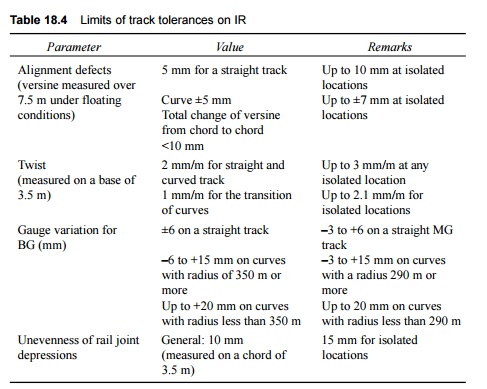Chapter: Civil : Railway Airport Harbour Engineering : Railway Engineering : Track Maintenance
Railway Track Tolerances
Track Tolerances
The safety and comfort of travel
depend primarily on track geometry and the standard at which it is maintained.
In practice, it is not possible to obtain a flawless and perfect track; the
parameters governing track geometry always show certain variations due to
various reasons. Track tolerances may be defined as the limits of variability
of various parameters pertaining to track geometry.
1 Track Parameters
Tolerances are generally laid down for the following track
parameters.
Gauge variation This is
measured as the deviation from the nominal gauge, which is 1676 mm for
BG and 1000 mm for MG. The gauge is measured as the minimum distance between
the running faces of two rails.
Unevenness This is
measured in terms of the difference in longitudinal levels over a fixed
base. Unevenness is generally measured over a base of a length of 3.5 m. It is
measured separately for left and right rails.
Cross level difference This is
measured in terms of the relative differences in the level of two rail
tops measured at the same point. Cross level difference also includes the
variations in superelevation.
Twist This is
measured in terms of the change in cross levels per unit length of measurement.
Twist is calculated after knowing the cross levels and the difference between
two points over a fixed base of, say, 3.5 m and dividing the cross level
difference by this base length. This is normally denoted as mm/m.
2 Safety Tolerances
Safety tolerances are the limits
of variation beyond which the movement of traffic on the track becomes
dangerous or unsafe. The kind of unsafe conditions that arise depend not only
up on the condition of the track but also on the type of vehicle, its riding
characteristics, and its standard of maintenance. The factors that govern these
unsafe conditions are so variable and indeterminate that almost none of the
railway systems in the world have laid down any safety tolerances. It is generally
believed that possibly the track would have to deteriorate to a great extent
for it to reach these unsafe limits.
3 Track Tolerances for Good Riding
Quality
The limits of track tolerance
prescribed in order to guide engineering officials regarding the suitability of
the standards of track maintenance on BG tracks with a sanctioned speed of
above 100 km/hr and up to 140 km/hr are presented in Table 18.4.
Table
18.4 Limits of track
tolerances on IR

There are no special tolerance
limits for cross level defects. The track should be maintained at a standard
that is generally superior to that of main line tracks where unrestricted
speeds of up to 100 km/hr are permitted.
The
provisions and tolerances mentioned here and elsewhere in the chapter have been
provided with a view to maintain track geometry so as to ensure a comfortable ride
and not from the point of view of stability or safety. (Source: ACS No. 96 of
2004 issued under Railway Board letter no. 2004/CE-II/CS-I dated 22 July).
Related Topics